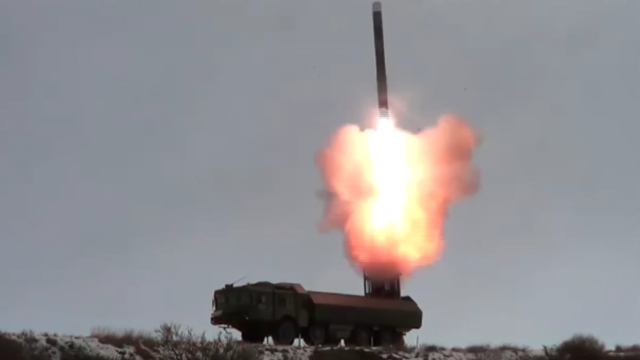
Behind Moscow’s Arms Control Offensive
Publication: Eurasia Daily Monitor Volume: 17 Issue: 31
By:

Russia has a long track record of importuning the United States and its allies regarding arms control treaties and negotiations. But the sentiment Moscow presents to the West is far from altruistic. Indeed, having largely completed its nuclear modernization and reached the limit of what it can spend on defense, Russia wants to lock in its gains before the US can begin the “aggressive modernization” of its nuclear weapons and before the North Atlantic Treaty Organization (NATO) can react with deployments to counter Russian violations of the now-defunct Intermediate-Range Nuclear Forces (INF) Treaty. Those violations apparently go beyond the Novator (9M729, a.k.a. SSC-8) missile to include other land-based cruise missiles. This Russian offensive travels on two tracks. As regards the INF Treaty, Russia is pursuing negotiations with European states and making public proclamations in favor of a moratorium on short- and intermediate-range missiles in Europe (TASS, February 18). Moscow does so knowing that nobody has retaliated to date even though it built and deployed numerous INF-noncompliant systems that can be easily hidden and then strike European cities and targets (UAWire, February 22). As for the second track, Russia continues to threaten the US and Europe with retaliatory measures should they choose to react to its violations of the INF Treaty (Kremlin.ru, February 20, 2019).
On the one hand, Moscow is feigning horror at NATO’s recent nuclear tests (RIA Novosti, February 22, 2020); only Russia, it seems, has the right to threaten potential adversaries with nuclear strikes (see EDM, October 21, 23, 29, 2019 and November 7, 2019). Equally importantly, Russia is strongly advocating for the immediate resumption of arms control talks, either to extend the New START strategic arms limitation treaty as is, or to negotiate a new one right away. Here again Moscow’s motives are transparent. As noted above, Russia needs to stop the US and potentially China from engaging it in a three-way nuclear weapons race that it probably could not sustain and that would also eclipse its efforts (or so Moscow believes) of the last ten years. Therefore, US reluctance to accept these Russian initiatives, including Russia’s continuing insistence on China joining any such talks, is regarded by Moscow officials as an effort to wreck the entire arms control regime (TASS, November 1, 2019).
Furthermore, Russia would like to lock in its newly developed weapons (some of them already tested, others undergoing such trials now) precisely because they either violate the INF or circumvent New START—for example, the weapons that President Vladimir Putin revealed at his March 2018 address to the Duma (Kremlin.ru, March 1, 2018), including a suite of hypersonics. Thus, in January of this year, Russia tested to over 500 kilometers its new hypersonic Tsirkon missile (TASS, February 27). In this respect, the Tsirkon—like the Oniks, which also flew over 500 km in its tests—is de facto an intermediate-range weapon. Although both the Oniks and the Tsirkon are presently intended to be ship-based anti-ship missiles, they both notably originated as land-based cruise missiles and have subsequently been converted into the new naval format. This is key since the INF Treaty’s flight-range restrictions (prohibiting ranges of 500–5,000 km) specifically applied to ground-launched systems. The Oniks missile is carried by the Bastion ground-launched coastal cruise missile system, and it was deployed for about ten years while the INF Treaty remained legally in effect (TASS, September 27, 2019). Thus, it arguably represents another treaty violation—and as noted above, the Tsirkon possibly does as well. The previously deployed Kalibr missile (2,000 km flight limit), also from the Novator design bureau, similarly originated as a land, sea, and airborne cruise missile of intermediate range.
These deployments conform to the ongoing Russian practice of adapting land- and sea-based cruise missiles for use on other platforms, including aircraft. And they further suggest that negotiating any new arms control treaty with Moscow would face difficulties in working out a satisfactory verification mechanism for Russia’s new intermediate- and short-range nuclear or hypersonic missiles. Those classes of systems have long been developed and fielded by China (not having been a party to any US-Soviet Cold War–era strategic arms control agreement). But Moscow has hitherto proved utterly unable to persuade Beijing to negotiate, despite stating a decade ago that it would not discuss any new arms control treaties unless they were multilateral—i.e., included China. This reality clearly raises questions about Moscow’s purported leverage over its “ally” in Beijing (Yaleglobal.yale.edu, January 23, 2020). Moreover, Russia’s routine boasting about just how many precision-strike and other weapons it has built in the last decade demonstrates that it does not genuinely seek peace; and it certainly belies Russian claims that Moscow would not be the first to deploy new (formerly treaty banned) weapons following the demise of the INF (see EDM, February 13). Finally the unresolved problems in the defense industrial sector, coupled with the real constraints on defense spending, may force Russia to rely even more on its nuclear weapons. These trends will make any future arms control talks even more problematic, especially if Chinese involvement or proper verification cannot be ensured (see EDM, February 27).



